K.G. William Dahl of Bethphage Mission
The youthful William and Lillie Dahl

For the remarkable story of K.G. William Dahl we are indebted to our Swedish language mentor and friend Rev. Earl Helge Byleen and our friends Rev. Bruce and Joan Berggren who provided the book containing the letters quoted here. These friendships date from our time in Stromsburg where one of Dahl's descendants also lived.
Dahl was one of those Swedes who eluded their characteristic reticence and became in his short life a visionary who undertook great ventures for the church. He is best known as the founder of the Bethphage Mission of Axtell, Nebraska. From the scores of letters and diary entries preserved by his family and translated by Byleen we have chosen but a sampling from which to reflect on his story.
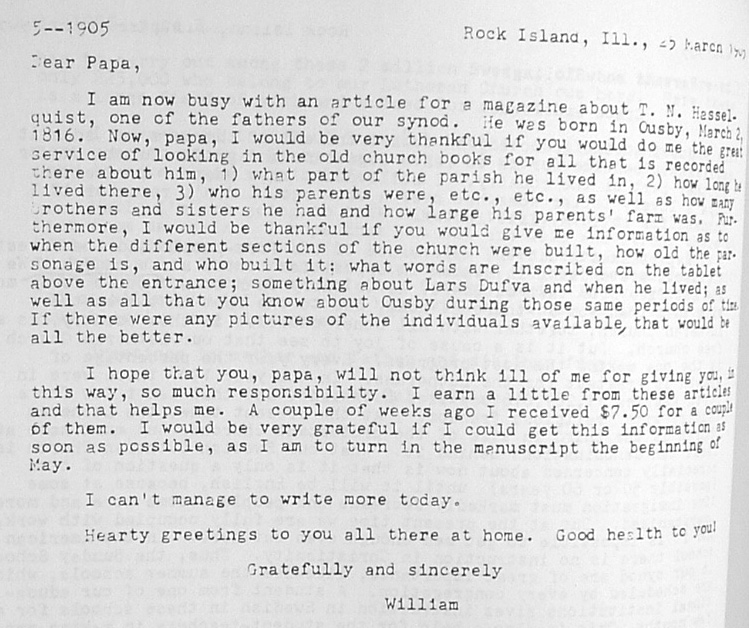
The first letter illustrates Dahl's devoted and copious correspondence with his family back in Sweden. From it we learn that his Osby, Skåne home was near that of Augustana founder T.N. Hasselquist and that he is researching the background of this revered churchman. One of Dahl's eulogizers speaks of his gentle and pleasing "Skåne nature". On his cherished and only visit home, he makes a point of visiting Hasselquist's birthplace. This little note is written to Dahl's father, priest of the parish church and later advanced to the office of Dean. It is also learned that Dahl's grandfather was also a priest and on occasion Dahl dreams of returning to the parish to serve in the footsteps of his forbears. It also gives an example of his frequent and embarrassed references to financial requests made to his father. It is written while he is a student at Augustana college and seminary in Rock Island, Illinois, and the composite of his letters gives a colorful picture of student life there. His literary gifts are evident not only in the correspondence but in the references to his work in publishing. His first major translation from German of a book about "A Colony of Mercy" (barmhertighetskoloni) is seminal to his life. The letters are pictured as laboriously typed by Byleen.
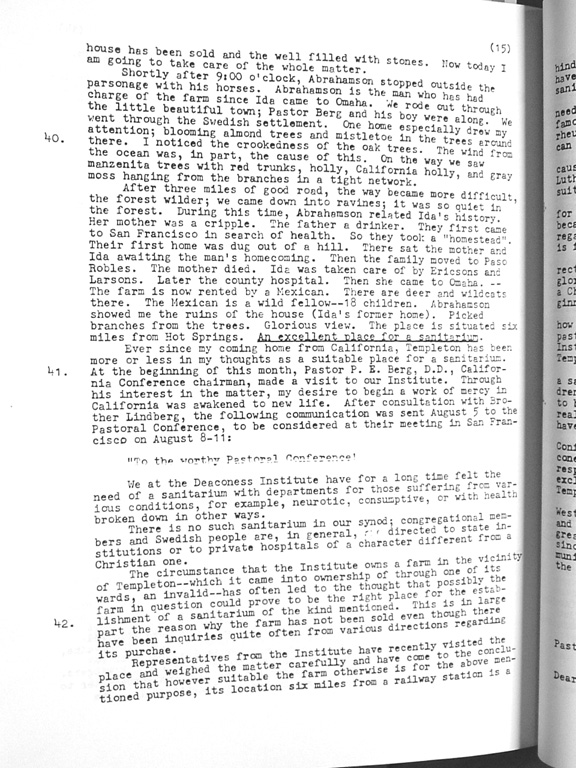
The second letter chosen continues the thread of Dahl's dream for a "colony of mercy" which would fill a need unmet by the broad purposes of Immanuel Hospital in Omaha where he then served as associate minister under Dr. Lindberg. His unbridled vision is prompted by personal contacts with those whose handicaps and dementia could not be served in the existing facilities and often were abandoned to dehumanizing institutions and situations. He cast about neighboring Florence and Benson looking for a site, and went as far as California in this quest as the letter shows. As proponent and fund-raiser for Immanuel he ventured throughout the Synod and met with great success. This may have given him encouragement that he could similarly marshall resources for his own dreams. These expressions from his letters reveal an inspiring altruism and great faith gripping this young man. In Omaha his wife Lillian and he are joined by little Samuel and Mariam in their new house. The Templeton California visit, near Paso Robles, is included to show one of the dreams that failed to materialize. In the meantime, Dahl's aspirations had unfortunately overflowed the vessel envisioned for him by his superior at Immanuel.
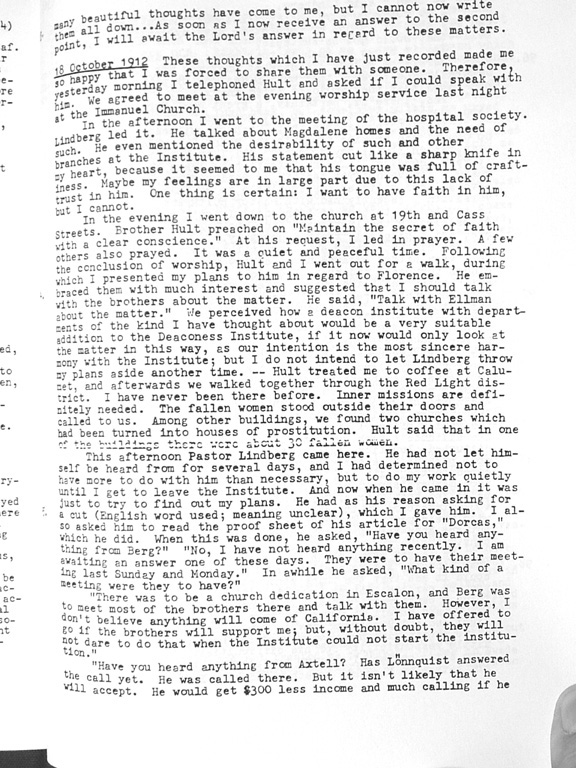
The third letter is a vignette of the Swedish section of early Omaha described as a little "Stockholm" by Beda Englund and detailed elsewhere on this website. The church which he mentions on Cass street is the old Emmanuel church which anchored this neighborhood. His conversations with Hult reveal the tensions at the hospital, the disappointment in California, and something colorful about an adjacent neighborhood to the east. Elsewhere we locate and describe the city mission work of brother Stuberg and his Swedish Holiness church, which is in just this area. What we were astonished to learn was that at least one brothel existed in a former church building! An unexpected chapter for "The Swedish Churches of Omaha." We refer the reader to the map outlining Beda's neighborhood, where the Swedish Auditorium also found the encroaching vice district troublesome.
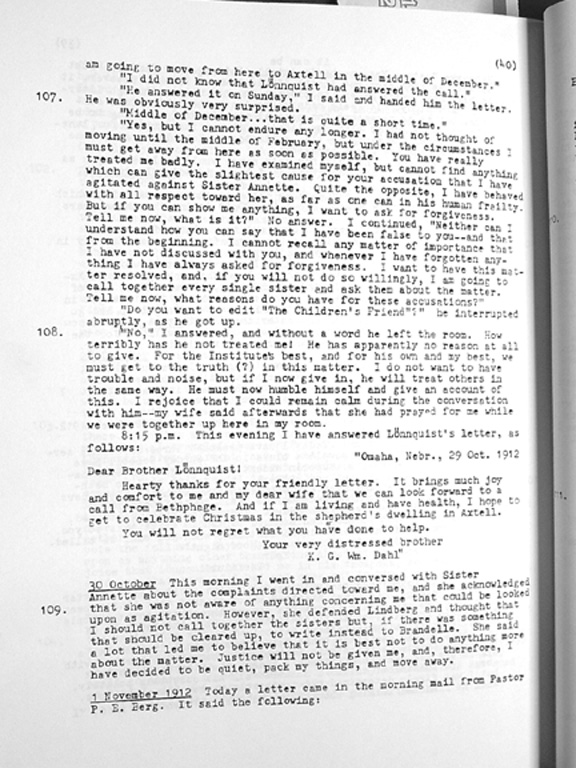
In the fourth letter the agony of human alienation stands as it always does, a sad lesson in frailty and ambiguity even in the context of great and noble deeds. It really needs no explication. It may be that part of the Dahl story which his descendants found "shocking." But it was perhaps these pangs which marked the birth of the superlative undertaking at Axtell which were to bloom in a few short years. The ongoing story of Bethphage and its global reach in a century to come remains the pride of Augustana and especially of Nebraska Lutherans of Swedish descent. For more on Bethphage please visit their website. A colony of mercy, styled after the architecture of Skåne and born of burning compassion.
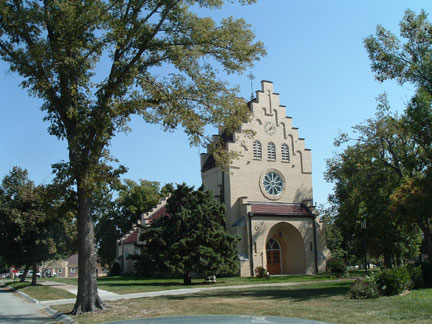
Dahl's lasting monument, the Bethphage Mission
Here its distinctive chapel
A postscript to Dahl's story notes his "take" on one of our figures of interest in the Swedish church. We have written of him elsewhere, but these insights reinforce our notion that the term "Schartauan" for Dahl as for historian C.F. Sandahl of Swede Home, Nebraska, was a kind of "code word" for that type of religious style embraced by many Swedes. We are ready to suggest that this code word meant in part "not Methodistic", that is, more formal and deliberate expression of faith and worship avoiding elements which might be subjective, enthusiastic, or "charismatic." It was these latter innovations which offended the sensibilities of some of the Lutheran läsare (readers) in the Swedish revival movement. But after re-reading Dahl's comments it might be that he himself has some reservations about the Schartauan style. Perhaps it is in fact his father and grandfather that are the Schartauan advocates. Sandahl is more unequivocally "Schartauan."
"Next Thursday I am going to give a lecture to the graduating class on Henrik Shartau, and it has taken me quite a bit of time and labor to develop this lecture. The more I study this godly man's life, the more respect I have for him without calling myself a "schartauan", as there have been more than enough who have tried to imitate him, but have never become anything other than Pharisees--and some of these are even found in our synod" letter 4-07
"Thanks for the little pamphlet. I can make use of it. I am going to have it printed by the book concern, with one or two small changes, if papa has nothing against so doing. Can I put papa's name on it, as the one who developed the plan? Or is it grandpa's? It is Shartauan in every way both to arrangement and contents." letter 14-06
"...there are abundant opportunities here at the Synod's Deaconess Home in Omaha, where Pastor Lindberg, an earnest man, a Schartauan, is superintendent." letter 3-07
Finally we must include a comment about the mission friends, some of whom Dahl encountered in his visit to Kearney. They were probably not Schartauan and evidently liked Dahl a lot.
"In Kearney there is, naturally, a free-congregation and they, of course, they do all they can to work against the Lutheran church, but--imagine this--the other evening their entire congregation was present in my church. I have never preached as I preached that evening, so said each one, and I know that I have never felt God's nearness as clearly as I did then. The people even said that if I could stay here longer there soon would be no free-congregation." letter 16-04